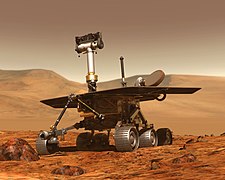Portal:Robotics
From Wikipedia, the free encyclopedia
Culture · Geography · Health · History · Mathematics · Natural sciences · Philosophy · Religion · Society · Technology
Robotics is the science and technology of robots, including their design, manufacture, and application. Robotics requires a working knowledge of electronics, mechanics, and software. A person working in the field is a roboticist. The word robot was introduced by Czech writer Karel Čapek in his play R.U.R. (Rossum's Universal Robots) (1920), while the word robotics was first used in print by Isaac Asimov, in his science fiction short story "Runaround" (1941).
A robot is an electro-mechanical or bio-mechanical device that can perform autonomous or preprogrammed tasks. Robots may be used to perform tasks that are too dangerous or difficult for humans, such as radioactive waste clean-up, or may be used to automate mindless repetitive tasks that should be performed with more precision by a robot than by a human, such as automobile production.
The word robot is used to refer to a wide range of machines, the common feature of which is that they are all capable of movement and can be used to perform physical tasks. Robots take on many different forms, ranging from humanoid, which mimic the human form and way of moving, to industrial, whose appearance is dictated by the function they are to perform. Robots can be grouped generally as mobile robots (eg. autonomous vehicles), manipulator robots (eg. industrial robots) and self reconfigurable robots, which can conform themselves to the task at hand. Robots may be controlled directly by a human, such as remotely-controlled bomb-disposal robots and robotic arms; or may act according to their own decision making ability, provided by artificial intelligence. However, the majority of robots fall in between these extremes, being controlled by pre-programmed computers.
The Foster-Miller TALON™ robot is a small military robot designed for missions ranging from reconnaissance to combat. It is a tracked vehicle said to be one of the fastest robots in the market. It can travel almost anywhere, through sand, snow, underwater (out to depths of 100 feet), climb stairs (a feat for any modern robot) and all the while showing the operator, up to 1,000 m away, the world in color, black and white, infrared, and night vision. It can run off lithium-ion batteries for a maximum of 7 days on standby before needing recharging. It can also withstand repeated decontamination allowing it to work for long periods of time in contaminated areas. It was used in ground zero after the September 11th attacks working for 45 days with many decontaminations without electronic failure. This led to the further development of the HAZMAT Talon.
It weighs less than 100 lb (45 kg) or 60 lb (27 kg) for the Reconnaissance version. Its cargo bay accommodates a variety of sensor payloads. The robot is controlled through a two-way radio or fiber optic line from a portable or wearable Operator Control Unit that provides continuous data and video feedback for precise vehicle positioning.

Credit: Dominic Hart, NASA
The Puma Robotic Sensor Arm for use in virtual reality development and studies at the NASA Ames Research Center, Mountain View, California.
Concepts: AI - Automation - Behavior - Calibration - Control - Cybernetics - Human interaction - Kits -Locomotion - Mapping - Mechatronics - Microbotics - Nanorobotics - Neural network - Odometry - Pathfinding - Servomechanism - Software - Vision
Developments: AI - BattleBots - DARPA - ELROB - FIRST - IARC - Mars Rover - RoboCup - Robotica - Robotics Institute
Fields: Androids - BEAM robotics - Biomorphics - Bionics - Cyborgs - Domestic - Gynoids - Industrial - Military - Surgical - Swarm - Telerobotics
Robots: AIBO - ASIMO - Boeing X-50 - KHR-1 - Lego Mindstorms - Leonardo's robot - Mecha - MQ-1 Predator - nEUROn - QRIO - SIGMO - Wakamaru - X-47 Pegasus
Fiction: Bender - Bishop - Blade Runner - C-3PO - Johnny 5 - Marvin - Metropolis - R2-D2 - R.U.R. - The Matrix - The Terminator - Three Laws of Robotics - Transformers - Wall-e
Lists: Autobots - Robot Hall of Fame - Roboticists - Robotics topics - Robots from Futurama - Star Wars droids - UAVs
Remotely operated underwater vehicles (ROVs) is the common accepted name for tethered underwater robots in the offshore industry. ROVs are unoccupied, highly maneuverable and operated by a person aboard a surface vessel. Most ROVs are equipped with at least a video camera and lights. Additional equipment may include sonars, magnetometers, a still camera, a manipulator or cutting arm, water samplers, and instruments that measure water clarity, light penetration and temperature.
The US Navy funded most of the early ROV technology development in the 1960s. This created the capability to perform deep-sea rescue operations and recover objects from the ocean floor. The offshore oil & gas industry created the work class ROVs to assist in the development of offshore oil fields. They are used extensively both in the initial construction of a sub-sea development and the subsequent repair and maintenance.
Archive/No

















No comments:
Post a Comment